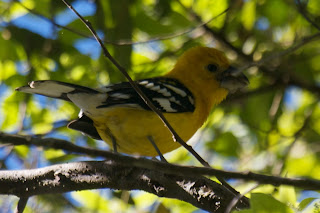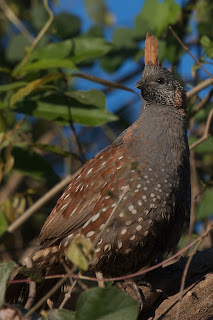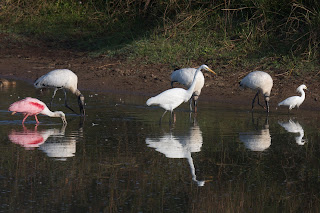 |
| Russet-crowned Motmot © Mark Stackhouse |
The San Blas Christmas Bird Count (CBC) for the 111th CBC season was held on Sunday, January 2, 2011. The first San Blas CBC was held in 1974, making this count one of the oldest in Mexico. Although the count was conducted most years for the first fifteen years, since the 1990's it has only been done intermittently. This year marks the 20th time overall that the San Blas count has been conducted. I hope that this year will mark the start of a new period of annual counts in San Blas.
Seven intrepid birders in four different parties went out on count day, enjoying near-perfect weather, and spending 25 party-hours in the field. Overall, it was the fewest birders and least amount of party-hours of any of the San Blas counts, so the coverage of the count circle was incomplete at best. We desperately need more birders to do justice to this count - historically one of the world's richest CBC's. Hopefully, more birders will join us for next year.
In spite of having so few birders, a total of 271 species were recorded, the third highest species total for the San Blas CBC (292 species in 1983-4 was the highest count). On count day, 224 species were found. Another 47 species were found during count week (3 days before and 3 days after count day). The fact that much of the circle was not covered, or only sparsely covered, led to low numbers being recorded for many species compared to past years. However, high counts were recorded or tied for 9 species, and another 8 species were recorded for the first time on the count.
 |
| Gray-collared Becard © Mark Stackhous |
While there's no easy explanation for the high counts for some species, such as Rufous-bellied Chachalaca, Swainson's Hawk, or Northern Rough-winged Swallow, for other species it seems to be a result of recent changes in both the environment and the locations for birding around San Blas. High counts for two species, Snail Kite and Limpkin, appear to be part of an ongoing trend of increasing numbers for both of these species that started after they became established here about eight years ago, following the invasion of apple snails in the mangroves. Two other high counts, Colima Pygmy-Owl and Golden Vireo, along with a tie for the previous high count for Gray-crowned Woodpecker, probably result from the recent development of Tecuitata as a birding site, and it's inclusion in the count this year for the first time. Tecuitata is an excellent place for seeing all three of those species, and was the location of two of the count-first birds, Crested Guan and Black Hawk-Eagle. The final high count, for Gray Silky-Flycatcher, occurred at an enormous strangler fig tree near Mecatan on the southeast edge of the count circle that was in fruit, and was also the site of another count first species, Cedar Waxwing.
 |
| Yellow Grosbeak © Mark Stackhouse |
 |
| Gray Silky-Flycatcher © Mark Stackhouse |
The other new species for the count include Bat Falcon, a species that is being seen with increasing regularity here in recent years (and was a staked-out individual in Singayta), and Virginia's Warbler and Brewer's Blackbird, both rare to uncommon winter visitors. Two more "new" count species involve changes in taxonomy and "corrected" identifications. Golden-crowned Emerald was indicated as a new species for the count, although a sister species that occurs on the east coast of Mexico, Canivet's Emerald is listed for 15 of the previous counts. Golden-crowned is the correct form for here. In addition, King Rail was recorded for the first time, while Clapper Rail has been recorded previously. The true identity and taxonomic status of King and Clapper Rails ("Cling Rails") on the west coast of Mexico is unclear - recently some observers, including myself, have been identifying them as King Rails. Some are now saying that the west coast forms of Clapper Rail, which are virtually identical to King Rail, are, in fact, all King Rails (S.N.G. Howell, pers. comm.). In this count they have been recorded as King Rails for this reason, and because the birds observed occurred in fresh-water wetlands, as opposed to salt water, which has been the conventional means of separating the two in this part of Mexico.
 |
| Elegant Quail © Mark Stackhouse |
Some of the other good birds (rare or not easy to see here) found were Least Bittern, Broad-winged Hawk, Snowy Plover, Ruddy Quail-Dove, Lilac-crowned Parrot, Costa's Hummingbird, Gray-collared Becard, Tree Swallow, Cliff Swallow, Black-capped Gnatcatcher, Rosy Thrush-Tanager, Ruddy-breasted Seedeater, Dickcissel, and Yellow-headed Blackbird. Most of the San Blas regulars were found, thought there were some "big misses," including American Wigeon, Lesser Scaup, Redhead, Brown Booby, Elegant Tern, Nutting's Flycatcher, Flame-colored Tanager, and Red-breasted Chat. One rather rare bird here, Red Knot, was seen just before count week started, but couldn't be re-found.Places visited during the count include: San Blas Pond, San Blas sewage lagoons, Mirador de las Garzas, Rio San Cristobal, Singayta, El Palillo, Mecatan, Tecuitata, Miramar, Aticama, and La Bajada. Additional places visited during count week include Playa del Rey (Peso island), Playa del Borego, Chacalilla shrimp ponds, and Las Islitas. The center of the count circle is located about 6.25 miles east and slightly south of the main plaza in San Blas, at 21° 32.00' N and 105° 11.00 W.Please join us for next year - tentative date December 30, 2011.
 |
| Wood Stork, Great Egret, Snowy Egret, Roseate Spoonbill © Mark Stackhouse | |
|
|
|
|
|
|
|
|
|
|
|
|
|
|
|
|
|
|
|
|
|
|
|
|
|
|
|
|
|
|
|
|
|
|
|
|
|
|
|
|
|
|
|
|
|
|
|
|
|
|
|
|
|
|
|
|
|
|
|
|
|
|
|
|
|
|
|
|
|
|
|
|
|
 |
| San Blas Jay © Mark Stackhouse |
 |
| Elegant Trogon © Mark Stackhouse |
 |
| Orange-fronted Parakeet © Mark Stackhouse |









No comments:
Post a Comment